 |
Flying High With Electric Power!
The Ampeer ON-LINE!
Fly the Future - Fly Electric! |
|---|
Site Table of Contents
| President: | Vice-President: | Secretary-Treasurer: |
| Ken Myers | Richard Utkan | Rick Sawicki |
| 1911 Bradshaw Ct. | 240 Cabinet | 5089 Ledgewood Ct. W. |
| Commerce Twp., MI 48390 | Milford, MI 48381 | Commerce Twp., MI 48382 |
| (248) 669-8124 | (248) 685-1705 | (2480 685-7056 |
 | ||
| Board of Directors: | Board of Directors: | Ampeer Editor |
| David Stacer | Arthur Deane | Ken Myers |
| 16575 Brooklane Blvd. | 21690 Bedford Dr. | 1911 Bradshaw Ct. |
| Northville, MI 48168 | Northville, MI 48167 | Commerce Twp., MI 48390 |
| (248) 924-2324 | (248) 348-2058 | (248) 669-8124 |
| The Next Flying Meeting: Date: Saturday, Nov. 5 Time: 10 a.m.
Place: Midwest RC Society 7 Mi. Rd. Flying Flied | ||
| Jim Northmore We remember Jim, Midwest RC Society founder and long time EFO member. | September EFO Flying Meeting Highlights and photos from the September EFO Flying meeting on Sept. 3. |
| Upcoming Midwest RC Society Swap Shop Info Here's the info. | International Control Line Competition with Electrically Powered Models Fred Adler shares photos and information on a great control line competition. |
| Skymasters' Indoor Season Starts at the Ultimate Soccer Arenas Info about indoor flying this year in Pontiac. | Feedback Regarding the October 2016 Ampeer John Bell comments on the October issue and Ken responds and also discusses A123 cells again. |
| Another Look At Two 'Similar' Motors With Different ESCs and Timing Ken discusses how different ESCs and their timing advance affects two similar motors. | |
From Peter Waters Via Email Midwest RC Society founding member Jim Northmore passed on Sunday, August 28. Jim had been ill for a long while, and was a founder member of the Midwest RC Society. Jim was also part owner of MIN-X Radio Control, which made R/C systems in Detroit starting with single channel, developed excellent pulse control systems, and their digital Astromite, was a final product. These were made on Grand River Avenue. Jim was also a highly regarded professional photographer, and developed several processes that were used in production of the annual car catalogs. The studio used was Boulevard Photography in Highland Park. Jim was also a long, long time member of the EFO. We always had a great time at the field. We will definitely miss him.
The September EFO Flying Meeting The weather was absolutely perfect for the September 3 EFO flying meeting. There was an excellent turnout.  Denny Sumner, Carolynne Foss and Al Straub are seen on the flight line here. The beautiful blue sky can be seen as well. Keith Shaw did the maiden of Ken's new Dollar Tree foam board Stik. After Keith's great initial trimming flight, Ken continued to fly the plane through the mid-afternoon.  Ken holds his new Stik while Keith Shaw speaks with Bill Brown. Below are some of the planes Ken brought to the field, including the Son of Swallow, FMS SuperEZ trainer and the Stik. 
Roger Wilfong discusses Kevin Hille's new power system with him. Kevin had been flying his FliteTest foam board P-51 with a 3S LiPo system. He very successfully replaced that power system with a 2S A123 system and was pleased with its performance during several flights that day. 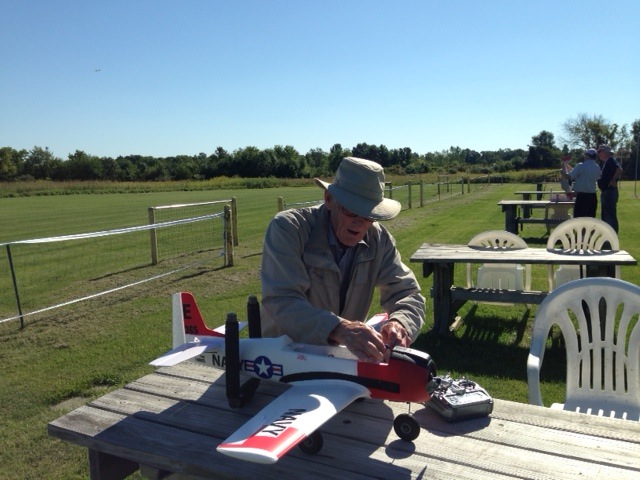 Bill Brown set up his parkzone T-28 for another great flight, but that is not what he was there for. At the 2013 Mid-Am, Keith flew Bill's scratch-built Wright Model B for the first time. It was more than a tad 'underpowered'. Bill changed the power system, and this meeting, almost three years later, Keith had a chance to try out the plane with its new power system. What a difference! The plane rose easily from the takeoff mat, and the new power system was just what was needed to get this plane in the air with good authority. The photo, a screen grab from Denny's video, shows the landing of a very successful flight. The video of the Model B landing can be viewed here.  It was most likely the best EFO flying meeting of 2016. The weather could not have been better. There was a lot of sharing of information and a lot of just 'plane' fun. Everyone really seemed to enjoy themselves, and everyone took home whole airplanes. 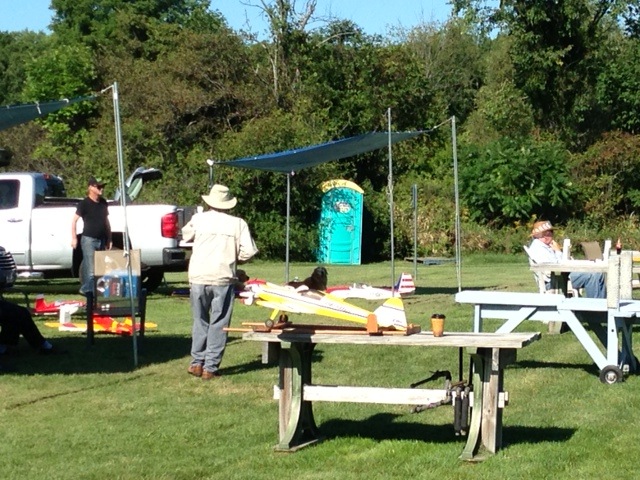 Thanks to Kevin Hille, short videos of the DTFB Stik looping can be seen at
Midwest RC Society
location
admission charge
vendor table cost
For Information
directions
THIS IS THE BEST AND LARGEST SWAP MEET IN SOUTHEASTERN MICHIGAN! Return to "What's In This Issue" A CIVY HEARSE
Ken, I thought you might get a kick out of my latest plane. It is a reduced size version of Paul Gliiam's CIVY HEARSE from 1950. The original was 400 square inches and intended for Class-A PAA Load competition. My version was scaled down to 250 square inches with a 41 inch span. It weighs 15.3 ounces. Power input is like 90 watts on a 3 cell 1300 pack. First flight will be early this morning. If all goes well the full construction article will appear in the October RC MICRO WORLD. Bob 
Return to "What's In This Issue" International Control Line Competition with Electrically Powered Models
Hi Ken, Attached to this email is a video of the C/L stunt winning flight (by an American). The model is electric. Of the 65 pilots from 20+ countries the choice was almost 50% electric powered, the rest, of course, glow powered. The electronics were mainly South African by Keith Reneckles (who competed). The advantage of this is it can adjust the motor speed bringing in extra power as the models nose lifts in manouvres and decreases power on down hill and level flight.  I got to see a fair few flights in-between judging combat flights. Lots of lengthy protests during which the judges could go watch the Aerobatics (the Russians do hate the Ukrainians and vice versa). The interesting thing to me were the props on many of the electrics were carbon fibre but hollow weighing nearly zero. They hold together on electric motors with continuous power whereas a glow motor's vibration would break them. It has advantages (reduces P factor) giving better manouvres. Go to www.cl-wch2016per.org to find competitors lists and about the Whiteman site. Last Saturday morning while my club (Soaring model Society of Western Australia) were flying electric gliders a very large hot air balloon went directly overhead at roughly 5000 feet less than an hour from breaking the round the world record.
Number 272 was plane from South African (Reneckles) designer of chip in many electronic stunters. 
Return to "What's In This Issue" Skymasters' Indoor Season Starts at the Ultimate Soccer Arenas
I know fall has some of the best outdoor weather, but it won't be long and things will be a changing. Indoor Flying will be starting up sooner than you think. This will be our 8th year at Ultimate Soccer Arenas - what a fantastic place for flying and fellowship through the dull winter months. Skymasters would like to make it our best year yet. Again this year we are offering 3 hour flying sessions from 10am-1pm. Our first indoor session is on Tuesday, October 25th. Winter Season Pass is $110 for the 25 sessions. It's our Best Deal.
On-line registration is open now for the Season Pass and Punch Cards. You must have a current AMA to register. Here is a link. Just scroll down the page and click on *Online Registration Open*. Now is the time to start looking over your indoor aircraft to see if it may be in need of repairs. Maybe its time to buy that new model, build that new foamy or at least invest in some new batteries. Here is a news flash - Flight Line Hobby is moving to a new location in the shopping center at Baldwin and Walden Road. The 25% larger location is at 3039 Baldwin Road, Lake Orion, MI. Looking forward to seeing everyone again soon. Fred E. Feedback Regarding the October 2016 Ampeer
Hi Ken, As a dedicated A123 user, I find this latest issue about as interesting as watching Grass grow! Sorry,
My thoughts and response: Hi John, Seriously, thanks, I do appreciate all feedback. I still use A123s in all my 'serious' planes. The only LiPo packs I have are 3S 1000mAh. They are used in the Old Fogey DTFB primary introductory trainer, the SuperEZ trainer and the DTFB Ugly Stik. The Stik is used as my flying discharger if there are left over charged LiPo packs after a training session. For me, LiPo batteries are an area of exploration and learning and I'll be getting back to a more diversified issue next month, promise. ;-) We have a lot of A123 users in our group, for sure, but lots of folks seem to be using LiPo packs, so thought I do some exploring. Actually, I think watching grass grow is like a 1000 times more exciting than the October issue. Thanks,
I started exploring and learning about LiPo batteries last December. What I believe I have learned is in the "Learning About LiPo Batteries" article online. I still much prefer A123 packs. FOR ME, LiPo packs require too much maintenance and fiddling. Since last December, I have tested and flown 10 different 3S 1000mAh packs from various sources and suppliers. Of the ten, two have died already. One pack made it to 38 charges and discharges before 'dying' and another only 9. On the morning of 9/19 I had all 8 of my 3S 1000mAh packs charged. I only flew two or three of the packs. I knew I'd be flying again on the evening of 9/21, so I left the remaining charged packs charged. I flew several of the LiPo packs that evening, but I still had more packs charged than I flew. On the morning of 9/22 I 'had to' charge two of the used packs to storage charge level and had to discharge two fully charged packs to storage charge level. All this messing around is totally unnecessary with my A123s. With A123 packs, I'm always ready to fly. I don't have to 'plan ahead' based on weather/wind prognostications. My A123 packs are left fully charged after the last flight of a day. They are ready to go anytime I am ready and the flying conditions are good. I don't have to guess at how many flights I might make in a day and possibly have 'charged packs' left over that may require discharging to storage level. I charge my A123 2300mAh/2500mAh packs at 10 amps, and that usually means they are fully recharged, at the flying field, in about 8 minutes, which I find perfect for BSing between flights. The EDF, 3D, helicopter, indoor fliers and drone folks really do need the power to weight ratio of LiPo batteries for the performance they require, but for me, A123 cells are my go to power supply for 3 lb. to 10 lb. planes that use a prop and fly on the wing, period. Another Look At Two 'Similar' Motors With Different ESCs and Timing
In the July 2016 Ampeer article "More on the Old Fogey's Old Fogies", I noted that two quite similar motors, in both weight and stated Kv, yielded different results with different electronic speed controls (ESCs) and different timing. The motor and ESC information is contained in the section titled "Power Systems" in the original article. I felt that it was important to separate that information and expand on it, as it might have been missed by some readers. The outrunner motors are the Cobra C-2217/20 and the EMAX GT2218/11.  Using diameter and length, stated Kv and weight the motors become:
In the original article I INCORRECTLY stated that the EMAX is a 12 pole/magnet motor. It is a 14 pole/magnet motor, just like the Cobra. I have often stated that similar weight brushless outrunner motors with similar stated Kv annotations by the supplier or manufacturer will produce similar results. One problem with this statement appears to be how the supplier, or the manufacturer, is deriving the stated Kv. I pulled the EMAX GT2218/11 from the Old Fogey prototype and the Cobra C-2217/20 from the Old Fogey 2. I used the drill press (spin) method, described in the article "The Electric Motor Constant Kv, AKA The Generator Constant, RPM/volt, Annotated as Kv" in the section titled "Measuring a motor's Kv Using the Drill Press Method" to calculate each motor's Kv. When this method is used to calculate the generator constant, there is no ESC involved and therefore there is also no timing advance involved. The calculated, mathematical, generator constant, using the drill press method for each motor:
Remember that the stated Kv numbers are:
I was not too surprised that the drill press Kv was different from the supplier's and/or manufacturer's stated Kv. I have seen this throughout all of my motor testing, of various outrunner motors, over a long period of time. A Castle Creations Phoenix Edge 50 amp ESC was extricated, with great difficulty, from my Freewing Pandora. The timing advance was already set to low (0) [note: CC does not indicted timing advance in degrees], as that is how I always set my timing. Both motors were retested with the CC Edge 50 amp ESC. All testing used the same props and same batteries. The tests were conducted in my basement, on the same day, with an ambient temperature of 19.5 degrees C. An Emeter II, with its remote data unit (RDU), was used to log the data. Using the logged data, the no load RPM divided by the no load volts yielded:
These numbers were extremely close to the drill press numbers, but still significantly different from the ones stated by the suppliers The logged two no load values and four prop values for each motor were entered into new motors in Drive Calculator. Drive Calculator derived the Kv, using no load RPM and no load volts, for each motor as:
The following table shows the actual, captured prop numbers during the test for each motor at the same voltage for the same prop.  As previously stated, the ESC, props, elevation, barometric pressure, ambient temperature and test instrument used for logging the data were the same for both motors under test. The Cobra's RPM was always greater than the EMAX at the same input voltage even though the Cobra has a lower measured Kv. This indicates that there was a greater voltage drop 'through' the EMAX motor. The EMAX motor is therefore less efficient than the Cobra. Could a user tell the difference in performance in the air on a given airframe? Probably not, but the EMAX definitely runs hotter than the Cobra and it is 'wasting' more energy. The wasting of energy actually did show up in the air. The Cobra/T-Bird 36 could easily fly for 6 minutes without dropping below 3.7V per cell resting at the end of the flight. The timer for the EXAX/T-Bird 54, the ESC I finally used with the EMAX motor, had to be set for 5.5 minutes to achieve the same resting voltage at the end of the flight. The following table was created to illustrate the differences.  The column labeled Volts Out is the voltage after the voltage drop through the motor. Both eff. % (efficiency of the motor and ESC) and Wout (estimated power out in watts) are based on estimates from Drive Calculator and also using Bob Boucher's prop formula. When I chose the power system for the prototype, I had not run the previous tests. The Cobra motor was first used in the prototype. I mated it with a Castle Creations Thunderbird 36 amp ESC. The Thunderbird 36 was chosen because it has plenty of 'head room', it is simple to use, it is less expensive, and it's considerably lighter than a CC Edge 50. Originally, I chose to bench test the Cobra/Thunderbird 36 without doing a drill press test. The CC Thunderbird line of ESCs do not have any adjustment for timing available either via the Castle Link program on the computer or via the transmitter. That is part of why they are simple. Using the RPM divided by the no load voltage to derive the APPARENT Kv yielded just over 900 and an Io (no load current) of 0.6 amps. The same test using the Edge 50 showed 870 Kv and 0.5 amps for the Io. The apparent Kv of 900 was still not near the supplier stated Kv of 960. The table below shows the difference between the CC Edge 50 and CC Thunderbird 36 ESCs using an APC 11x5.5E and 11.56 volts for the input. These numbers are Drive Calculator generated to keep them consistent.  It should be apparent that the Thunderbird is using some timing advance because both the RPM and amp draw are higher for the T-bird. The numbers still weren't too bad, so I chose to use this power system in the Old Fogey prototype. For the Old Fogey 2, I ordered the EMAX motor and an Emax Simon Series 20 Amp ESC from Heads Up RC Hobby Shop. I first bench tested the EMAX motor with the EMAX ESC's default timing of 15 degrees. The results were unacceptable. After fiddling around with transmitter programming for quite awhile, I was able to lower the timing to what I 'guessed' was supposed to be 0 degrees of advance. As far as I am concerned, ESCs that can ONLY be programmed using the transmitter should ALWAYS be avoided! Again, I was not satisfied with the results and tried the EMAX motor with the Thunderbird 36. The table below shows the results, normalized by Drive Calculator, for my tests. Again the APC 11x5.5E prop and 11.56V in was used.  The results for pairing the EMAX motor with the EMAX ESC were surprising and unacceptable! The EMAX motor paired with the T-Bird ESC was, to me, a more acceptable combination. I trash-canned the EMAX ESC. The Cobra/Thunderbird 36 system was installed in the Old Fogey 2 and the EMAX motor was placed in the prototype along with a CC Thunderbird 54 ESC, which I had on-hand. I remembered reading on RC Groups how Lucien Miller prop tested all of his Cobra motors. He stated, "To conduct the actual test, a motor and prop is mounted on the stand with an appropriately sized speed controller. I use a variety of speed controllers for the tests, depending on the size motor that is used, including Scorpion and Cobra brands, but all of the speed controllers are set to 8KHz PWM frequency and 15 degrees of timing advance for all the tests. I have taken one motor and cross checked all of the various ESC's used and found that they will all produce the same RPM and thrust numbers to verify that the controller itself is not introducing any variance in the data readings." I added the boldface to the stated "15 degrees of timing advance" to highlight it. After bench testing many Cobra brand motors for myself and others, I became suspicious of their stated Kv on the Innov8tive Web site. On March 31, 2016 I asked, on RC Groups, about the difference between the drill press (spin) Kv and the Kv stated on the Web site. "Lucien,
When the motor is driven by the drill press and analyzed, I was lead to believe that that is the 'actual' or 'native' Kv of the motor and that when advanced timing is used, the 'apparent Kv' is being changed. Yes/No?" To date, October 2, 2016, there has been no response from Mr. Miller regarding my questions, although he has answered several other questions regarding Cobra motors, in the same thread, since then. More information on this Cobra outrunner motor can be found here. Pulso and Cobra motors are 'related' and produced by the same manufacturer. Here is a link to how Cobra and Pulso motors are related.
I found it interesting that the Pulso X2217/20 has a stated Kv of 840. Could it really be that different from the Cobra's stated Kv of 960? Several other similar motors have stated Kv numbers much lower than the Cobra's 960. NTM Prop Drive 28-30S 800KV (2830-800Kv, 65g)
All of the previous information led me to believe that Lucien just didn't get the Kv written down correctly, although I found the Turnigy D2836/9 950KV (2830-950Kv, 70g). That motor is produced by ShenZhen Xingyaohua (XYH) Industrial Co., Ltd. Over the years, I have found that company's motor specifications to be unreliable, but maybe that Kv is close to correct. I was, and am, a bit perplexed by the information about the EMAX motor at Heads Up RC Hobby Shop. There are 3 tabs on the Web page containing information about the motor. The tabs are named; 'Description', 'Technical Specifications' and 'Prop Test Data'. On the 'Description' tab they state, "The APC 11x5.5E is a good all around prop for this motor, and we suggest that you give it a try for both sport and 3D flying. The APC 10x7E is a good choice for models designed for higher speeds." With those props, the motor combined with a 'good' ESC and low timing advance has an efficiency in the mid-60% range at wide open throttle (WOT) and the amp draw is near the stated maximum of "21 amps or 230 watts for 30 seconds", as stated on the 'Technical Specifications' tab. When flown with good throttle management, the motor ESC system is okay, but not that good. It also states on the 'Technical Specifications' tab, "Please note: The KV ratings we publish for the motors we sell are the direct result of our own testing and may not match the manufacturer labels, as often such readings may vary between manufacturerd (their spelling) batches of motors. We perform this testing to ensure that our customers have accurate specifications upon which to base the specific application of each motor." I found it interesting that Heads Up did find the apparent Kv to be exactly the same as the supplier, since it seems unlikely that they both used the same ESC and timing, if they used the RPM/no load voltage to derive the Kv. The 'Prop Test Data' tab shows data that they supposedly gathered. One very important data point is missing, RPM. I also question whether they actually recorded all the props at exactly 11.1V. You can't do that without a data logger of some type, and there is no indication that they used a data logger of any type. They do not mention what ESC was used for their prop testing, nor its timing advance. They do note, "Other factors, such as ESC timing and variations in actual motor KV can affect the performance of brushless motors as well." As I have hopefully demonstrated, both the brand, amp rating and timing advance have an affect on the final results in both power and efficiency. Bruce Simpson, of RC Model Reviews, is one of my favorite, and most trusted, go to sources for accurate information on the Internet. Unfortunately I believe he didn't do a very good job with his, "RC Basics: What is KV" video, January 20, 2013. He only covered how to determine the Kv by using the RPM/volts in. He used an optical tach, which is difficult to use and get accurate readings, especially inside. His power meter did not not hold the values. He never mentioned timing advance. I also believe that he missed a very valid point in the differences between the Afro 12 amp ESC and RotoGeek 12 amp ESC in the video "Does ESC choice affect motor power?", March 3, 2015. The video shows the following results. He did not gather RPM data.
While he stated that he made sure the ESCs were calibrated to use the full throttle range, he did not note the timing advance. My guess is that they were 'timed' about the same, but with the slightly lower input voltage for the RotoGeek, it is hard to say for sure. It appears, in the video, that the battery input wires on the RotoGeek 12 are a larger (smaller AWG) diameter than on the Afro 12. He never noted that. The wire gauge used on the ESC will have an effect. Even if you are not demanding a lot of power from your power system, how efficient is your system? You might want to check it out. To Reach Ken Myers, you can land mail to the address at the top of the page. My E-mail address is: KMyersEFO@theampeer.org |
